Delve into the tantalizing world of Pad Kee Mao, known affectionately as Drunken Noodles. Originating from the bustling streets of Thailand, this dish isn't just about its intriguing name—it's a culinary journey steeped in rich flavors and cultural fusion. Imagine succulent shrimp, vibrant vegetables, and aromatic Thai basil dancing in a fiery sauce, all-embracing tender rice noodles. Each bite offers a symphony of sweet, salty, and spicy notes, echoing the lively spirit of Thai cuisine.
Prepare to embark on an adventure where tradition meets innovation, where every ingredient tells a story of its own. Whether you're an enthusiast of global flavors or simply curious about expanding your culinary horizons, Pad Kee Mao promises an unforgettable dining experience that transcends borders and brings the vibrant essence of Thailand straight to your table.
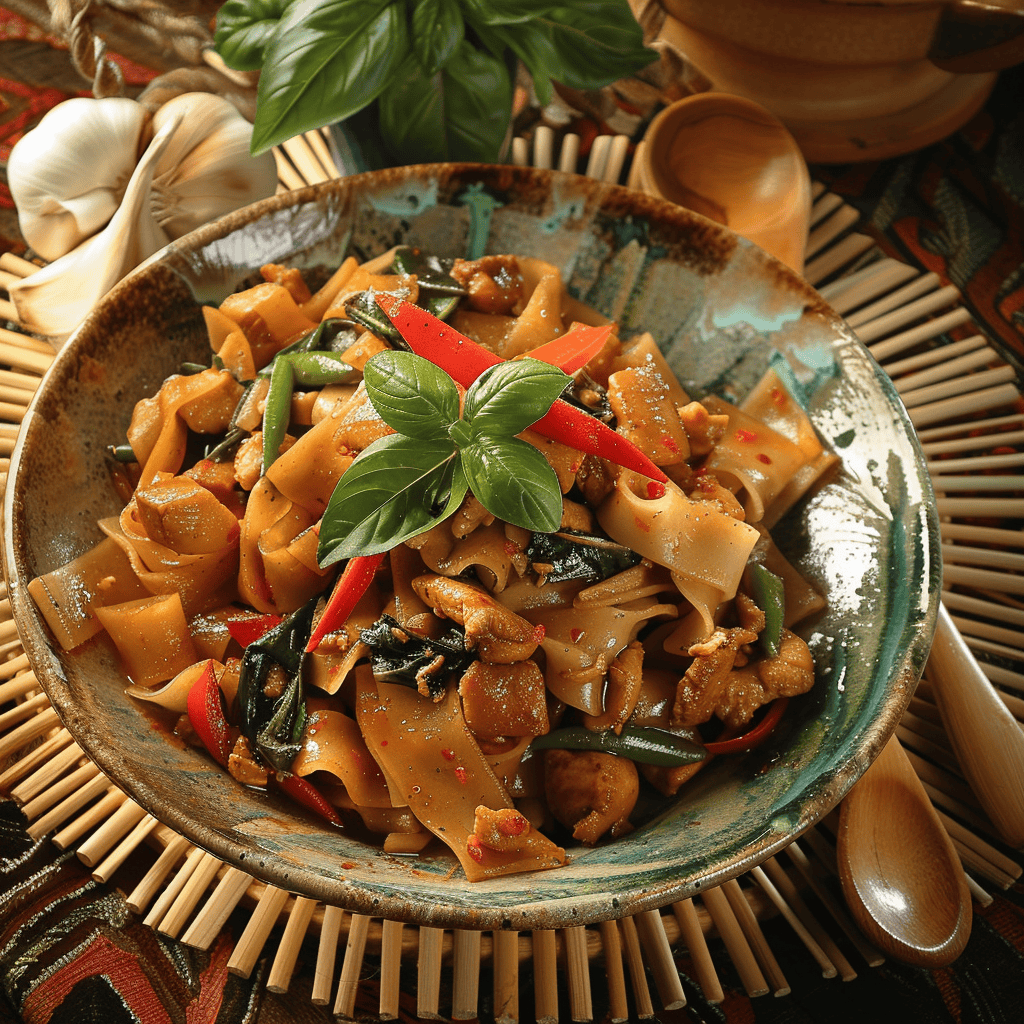
Pad Kee Mao, or Drunken Noodles, is storied in Thai culinary tradition. Originating in Thailand, the dish's name, "Drunken Noodles," is said to reflect its reputation as a favorite late-night snack among Bangkok's street vendors, satisfying hunger pangs after a night of revelry. Despite its playful name, the dish's history is deeply rooted in Thai culture, blending influences from Chinese stir-frying techniques with Thai spices and ingredients.
Historically, Drunken Noodles have been celebrated for their bold flavors and flexibility, allowing for variations in protein and spice levels to suit different palates. Today, Pad Kee Mao continues to captivate food enthusiasts worldwide, embodying Thai cuisine's vibrant and dynamic nature. Its popularity extends beyond Thailand's borders, making it a beloved dish in restaurants and kitchens globally, where its spicy allure and aromatic charm continue to entice adventurous diners seeking a taste of authentic Thai flavors.
Joyful celebration of Thai culinary traditions.

Sawasdee Kha, (Hello)
I adore Pad Kee Mao for its thrilling burst of flavors, perfectly capturing Thai cuisine's essence. The spicy kick from Thai bird chilies and the aromatic freshness of Thai basil make every bite exciting. It's incredibly satisfying to cook, blending simple ingredients into something spectacular in just minutes. Whether for a quick dinner or a special gathering, this dish always impresses with its bold flavors and vibrant presentation!
Three Reasons Why I love this recipe
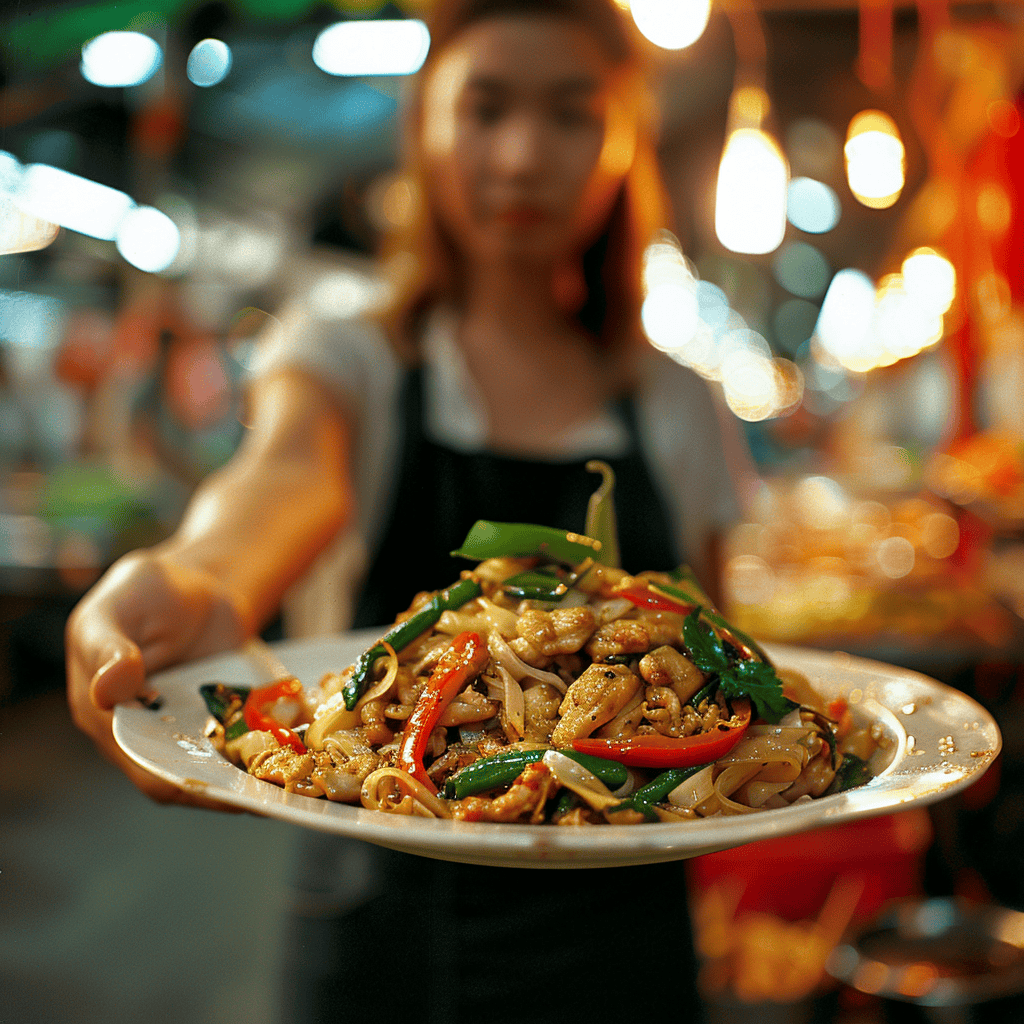
- Cultural Connection: Making and enjoying Pad Kee Mao connects me to Thai culture and cuisine, offering a delightful culinary adventure right from my own kitchen. It's like a mini getaway to Thailand with each spicy, savory bite.
- Flavor Explosion: The combination of Thai bird chilies, garlic, and fresh basil creates a truly unforgettable, spicy, and herbaceous flavor profile that I can't get enough of. It's a perfect balance of heat and freshness in every bite.
- Comfort Food: There's something incredibly so comforting about a hot plate of noodles mixed with hearty ingredients and a flavorful sauce. It's my go-to comfort food that always lifts my spirits and satisfies my cravings for something hearty and warm.
This dish isn't just a meal; it's a joyful celebration of Thai culinary traditions, and I'm thrilled every time I get to share it with friends and family.

WELCOME TO MY HOUSE! COME MAKE THIS PAD KEE MAO RECIPE WITH ME!
Ingredients For Drunken Noodles
Drunken Noodles, or Pad Kee Mao, is a vibrant and flavorful Thai dish that combines fresh ingredients with a savory, spicy sauce. The flat rice noodles serve as a perfect canvas for the rich, spicy sauce. Additionally, stir-frying the garlic and Thai bird chilies in vegetable oil releases their aromatic flavors, creating a robust base. Furthermore, adding your chosen protein, whether chicken, pork, shrimp, or tofu, adds a satisfying and nutritious element to the dish. Crisp bell peppers and sweet onions contrast the chilies' heat, while Thai basil leaves introduce a distinctive peppery flavor.
Moreover, combining oyster, soy, and fish sauces creates a deep, savory profile balanced by sugar. Additionally, black pepper adds a subtle heat, and the optional cherry tomatoes provide a juicy sweetness that complements the overall dish. Finally, garnishing with holy basil leaves adds an extra layer of freshness, making Pad Kee Mao a standout in Thai cuisine. This blend of flavors and textures ensures a well-balanced and memorable culinary experience.
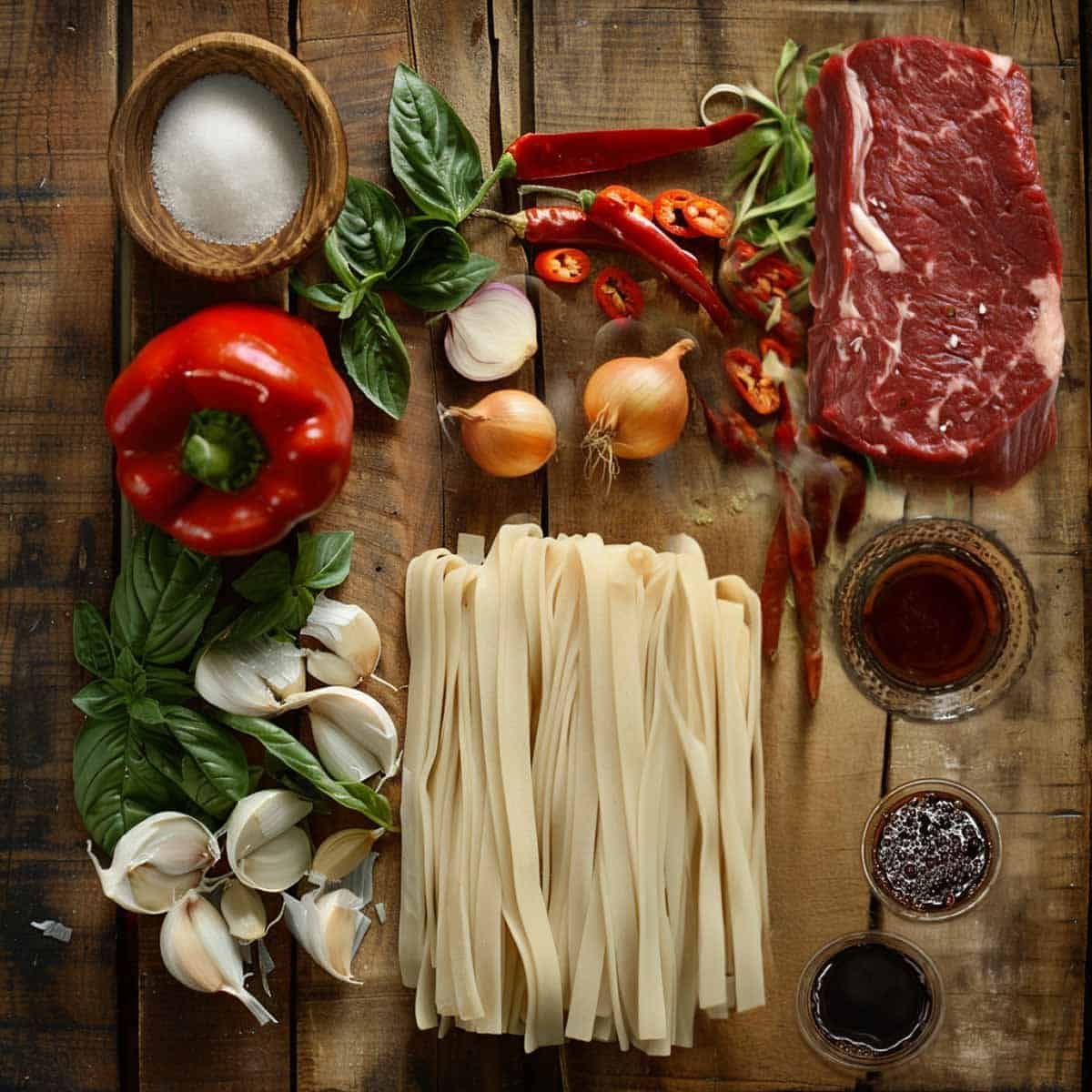
Preparing Noodles for Drunken Noodles (Pad Kee Mao)
To prepare the noodles for Drunken Noodles or Pad Kee Mao, soak the wide rice noodles in warm water for around 10 minutes until they become soft but still slightly firm. This step is crucial as it ensures the noodles are pliable yet maintain their integrity during the stir-frying process. Once soaked, drain the noodles thoroughly and set them aside, ready for the next cooking stage. Properly prepared noodles absorb the bold, savory flavors of the sauce while achieving the perfect balance between tenderness and chewiness, essential for an authentic and satisfying Pad Kee Mao.
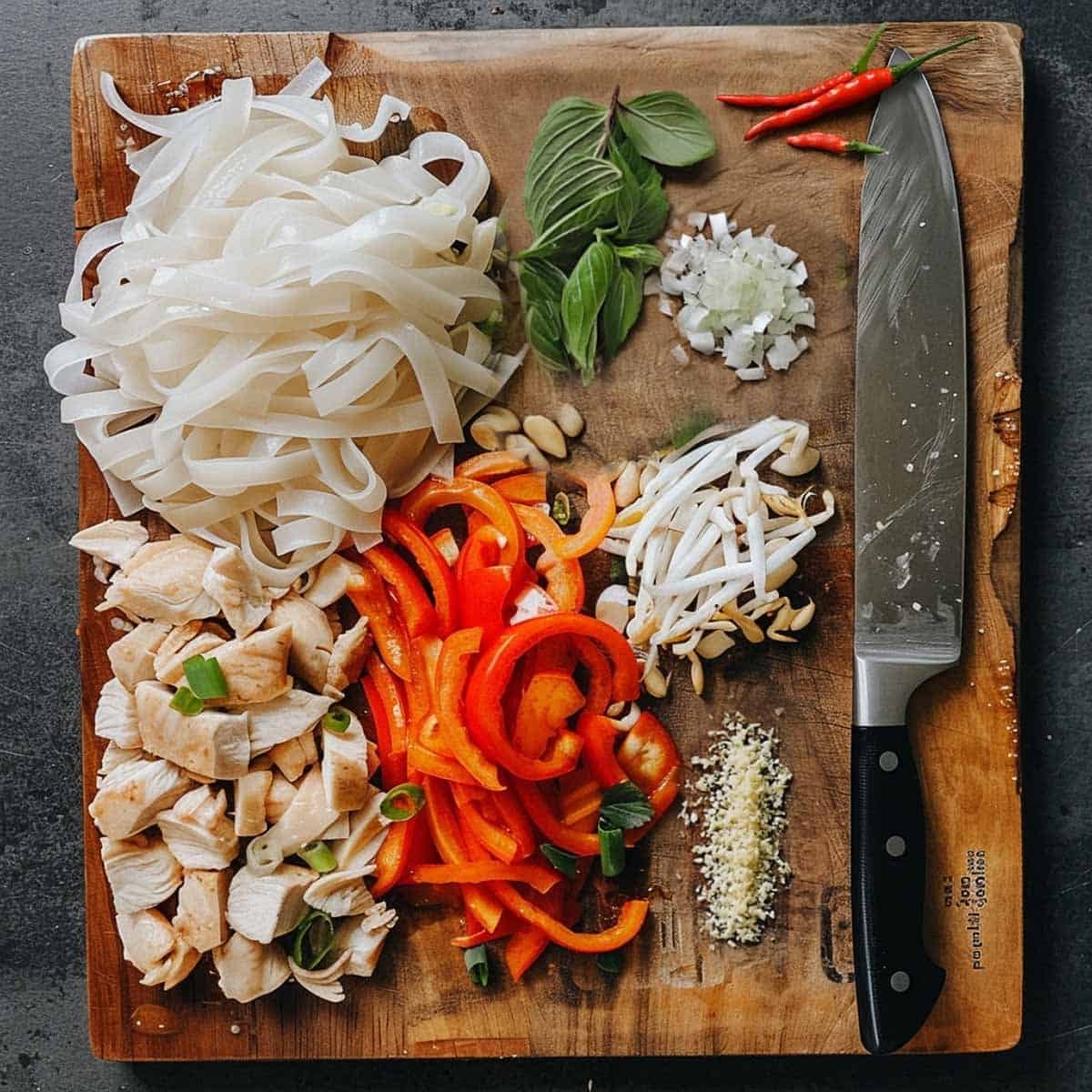
Crafting Perfect Pad Kee Mao: A Step-by-Step Guide to Flavorful Drunken Noodles
Heat a tablespoon of oil in a skillet or wok to medium-high heat.
Once the oil is heated, introduce minced garlic and sliced chilies, sautéing them for about 30 seconds until they become fragrant. This initial step is essential for creating the flavor base of the dish. Next, add your choice of protein—whether it's thinly sliced chicken, pork, shrimp, or tofu. Stir-fry the protein until it is fully cooked and develops a nice browned exterior, ensuring it is infused with the garlic and chili flavors. Once cooked, remove the protein from the skillet and set it aside. This process cooks the meat or tofu and enhances its flavor, making it a robust addition to the final Drunken Noodles dish
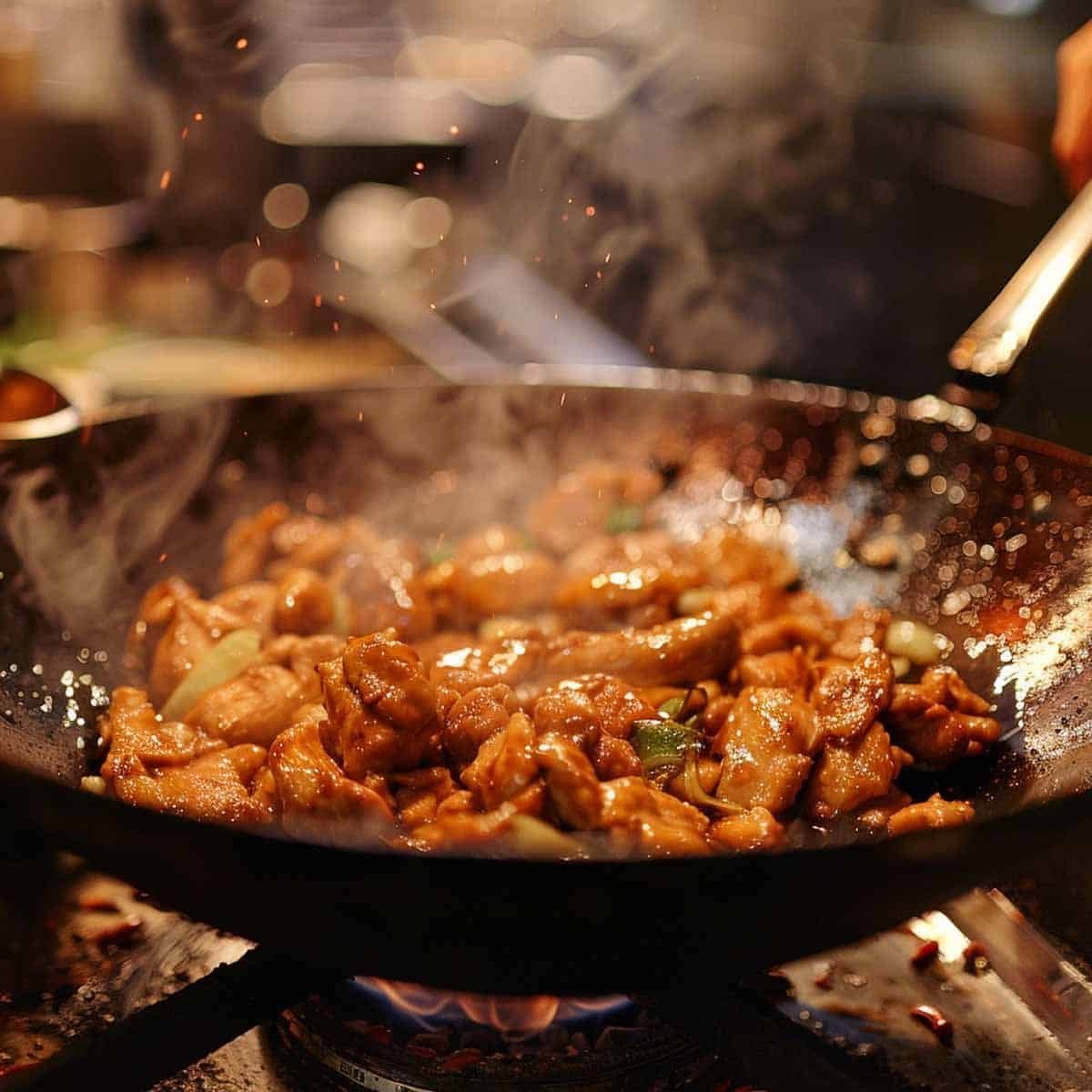
Stir-Frying the Vegetables and Combining Ingredients for Drunken Noodles
Add more oil to the same skillet if needed to cook the vegetables. Stir-fry the sliced bell pepper and onion until they soften, about 2-3 minutes. Return the cooked meat to the skillet. Then, add the drained noodles, sauces (oyster, soy, and fish), sugar, and black pepper.(oyster, soy, and fish), sugar, and black pepper. Stir-fry everything together for another 3-5 minutes until the noodles are tender and the flavors are well combined, resulting in a perfectly blended and tasty dish.
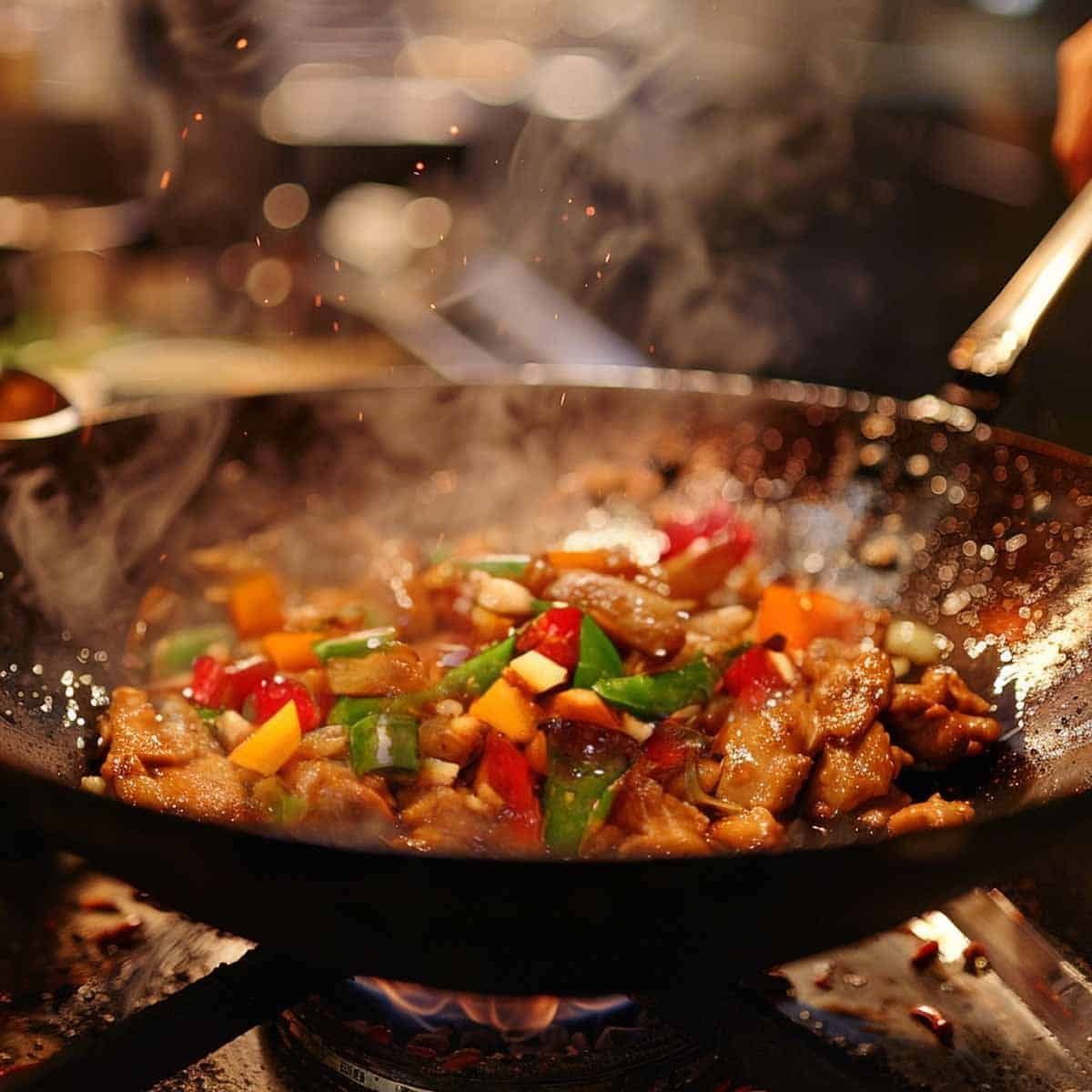
Final Touches for Perfect Drunken Noodles (Pad Kee Mao)
To complete your Drunken Noodles or Pad Kee Mao, first add cherry tomatoes and Thai basil leaves to the wok. Next, stir for one minute, allowing the tomatoes to soften slightly and the basil to release its aroma. Then, serve the noodles hot, garnished with fresh holy basil leaves and a wedge of lime. This final touch not only enhances the dish's visual appeal with vibrant colors but also adds fresh brightness and aromatic depth, ensuring a well-balanced and flavorful experience.
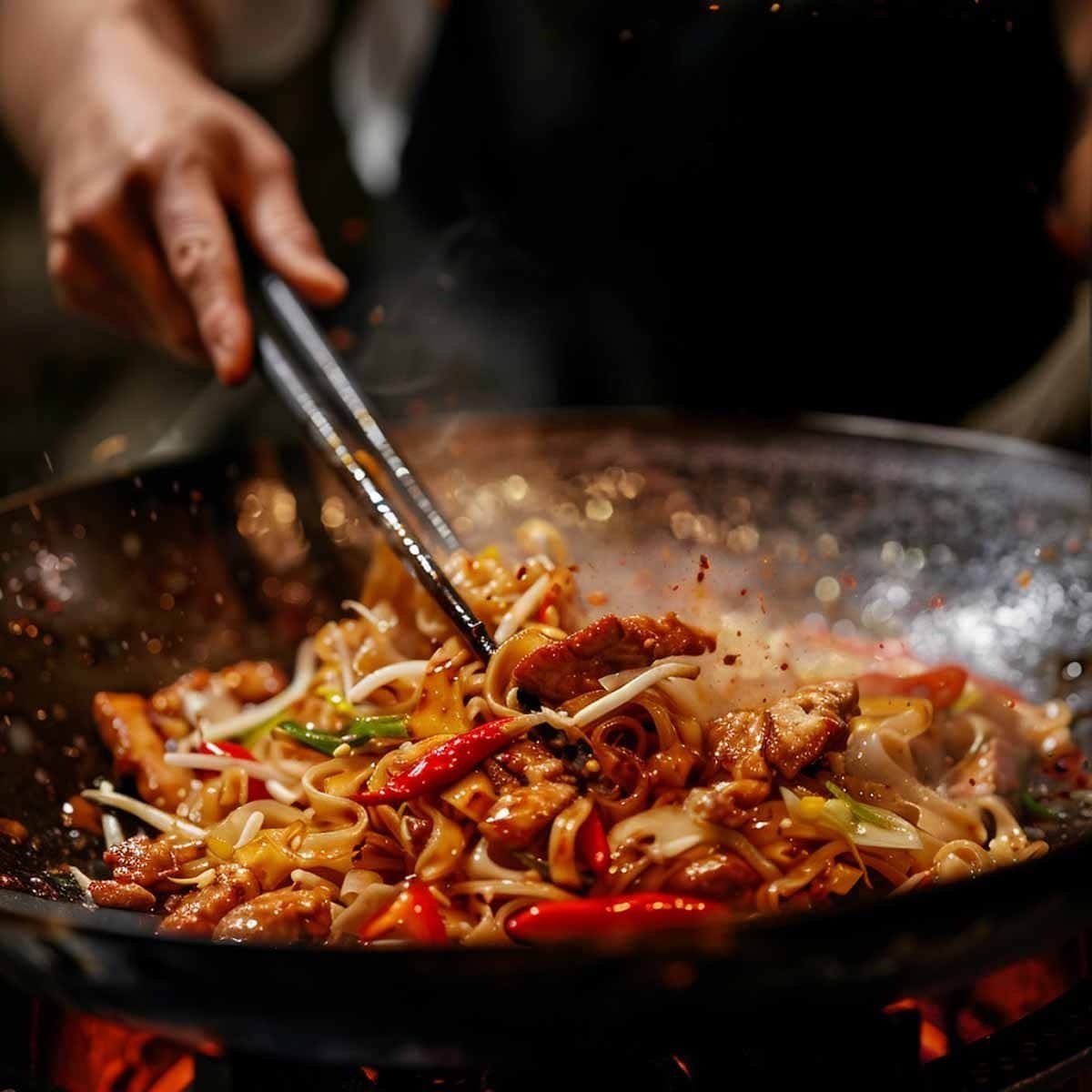
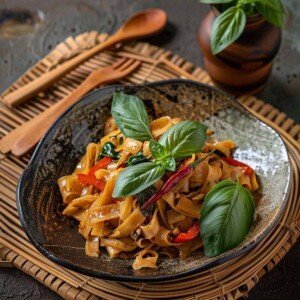
Pad Kee Mao (Drunken Noodles)
Ingredients
- 8 ounces flat rice noodles wide
- 2 tablespoons vegetable oil
- 3 cloves garlic minced
- 1-2 Thai bird chilies finely chopped (adjust to taste)
- ½ pound meat of your choice chicken, pork, shrimp, or tofu, sliced or prepared as preferred
- 1 medium bell pepper sliced
- 1 medium onion sliced
- ¼ cup Thai basil leaves
- 2 tablespoons oyster sauce
- 1 tablespoon soy sauce
- 1 tablespoon fish sauce
- 1 teaspoon sugar
- ½ teaspoon black pepper
- ½ cup cherry tomatoes halved (optional)
- ½ cup Thai holy basil leaves for garnish if available
Instructions
- Prepare the noodles:Soak the rice noodles in warm water for about 20 minutes until they are soft but not fully cooked. Drain and set aside.
- Cook the meat:Heat 1 tablespoon of oil in a large skillet or wok over medium-high heat. Add the garlic and chilies, and stir-fry for about 30 seconds until fragrant.Add the meat (chicken, pork, shrimp, or tofu) to the pan. Stir-fry until the meat is just cooked through and nicely browned. Remove the meat and set it aside.
- Stir-fry the vegetables:In the same skillet, add another tablespoon of oil if needed. Add the sliced bell pepper and onion, stir-frying until they start to soften, about 2-3 minutes.
- Combine ingredients:Return the cooked meat to the skillet. Add the drained noodles along with the oyster sauce, soy sauce, fish sauce, sugar, and black pepper. Toss everything together and stir-fry for an additional 3-5 minutes until the noodles are tender and everything is well mixed.
- Final touches:Stir in the cherry tomatoes (if using) and Thai basil leaves. Cook for another minute until the basil is wilted and the tomatoes are just heated through.
- Serve:Plate the noodles and garnish with fresh Thai holy basil leaves. Serve hot with a wedge of lime on the side, if desired.
Notes
Nutrition
Tips for Authenticity and Customization
Using Authentic Ingredients
To create an authentic Pad Kee Mao, it's essential to source ingredients that capture the essence of Thai cuisine. Start with rice noodles, ensuring they are fresh and of good quality to maintain their firm texture when cooked. For protein, opt for fresh shrimp, chicken, or tofu for a vegetarian option, ensuring they're tender and absorbent of the dish's flavors. Fresh Thai basil leaves are crucial for their distinct aroma and flavor profile, differentiating Pad Kee Mao from other noodle dishes.
For vegetables, choose vibrant options like bell peppers, snap peas, and carrots, adding color and crunch. Garlic and Thai bird's eye chilies give the dish its characteristic kick. A mix of soy, oyster, and fish sauce adds depth and umami. Use vegetable oil for stir-frying, as it complements the dish's flavors without overpowering them. These ingredients harmonize to create an authentic Pad Kee Mao, reminiscent of Thailand's bustling street markets and vibrant culinary traditions.
Adjusting Spiciness and Flavors
Adjusting the spiciness and flavors of Pad Kee Mao allows you to personalize the dish to suit your palate. To increase the heat, add more Thai bird's eye chilies during cooking or sprinkle with crushed red pepper flakes at the end. Reduce the amount of chilies or remove the seeds before slicing them for a milder version. Balancing the sweetness and saltiness can be adjusted by varying the amount of sugar, soy sauce, and fish sauce—start with the suggested amounts and taste as you go, adding more as needed.
To enhance umami, consider adding a dash of Thai seasoning sauce or a splash of chicken broth. To add a tangy flavor, squeeze fresh lime juice over the finished dish before serving. These adjustments ensure that Pad Kee Mao remains versatile, accommodating various tastes without compromising its authentic Thai essence.
Substitutions
Substitutions in Pad Kee Mao can accommodate dietary needs while maintaining its essence. Replace shrimp with chicken breast or thigh meat, thinly sliced and cooked until tender. For a vegetarian option, tofu works beautifully, absorbing flavors and providing protein. Substitute soy sauce with tamari for a gluten-free version, ensuring other sauces used are also gluten-free. Use agave nectar or coconut instead of regular sugar for a healthier alternative.
Vegetables can be varied based on availability and preference—try bok choy, broccoli, or snow peas instead of traditional bell peppers and snap peas. Swap rice noodles with zucchini noodles or bean sprouts for a lighter dish. Adjust quantities accordingly to maintain the dish's balance of flavors and textures. These substitutions allow Pad Kee Mao to remain adaptable while satisfying diverse dietary requirements, ensuring everyone can enjoy its delicious Thai flavors.
Alternative Garnishes
While traditional Pad Kee Mao is typically garnished with fresh Thai basil and lime wedges, there are alternative garnishes to explore that complement its bold flavors. Consider topping your dish with chopped cilantro for a fresh herbal note, or sprinkle with toasted sesame seeds for added crunch and nuttiness. Thinly sliced scallions add a mild oniony flavor, while a drizzle of sriracha or chili oil can intensify the dish's spiciness for those who crave more heat. For a refreshing twist, garnish with cucumber ribbons or a sprinkle of crushed peanuts to add texture and a hint of sweetness. These alternative garnishes provide creative ways to enhance the presentation and flavor profile of Pad Kee Mao while staying true to its Thai roots.
FREQUENTLY ASKED QUESTIONS FOR PAD KEE MAO.
If Thai bird chilies are unavailable, you can substitute with serrano or jalapeño peppers, adjusting the amount based on your heat preference. Cayenne pepper or red pepper flakes can also work in a pinch.
Absolutely! To make Drunken Noodles vegetarian or vegan, simply substitute the meat with tofu or, alternatively, add more vegetables like mushrooms, zucchini, or broccoli. Additionally, ensure that the oyster sauce is replaced with a vegan oyster sauce alternative made from mushrooms.
Thai basil is preferred for its unique flavor, but if it's not available, you can use Italian basil, though the taste will be slightly different. Adding a little mint might help mimic the anise-like flavor of Thai basil.
While any soy sauce can work, using a light soy sauce is often preferred for its saltiness and thinner consistency, which blends well without overpowering the dish. For a gluten-free option, tamari can be used instead.
To prevent the noodles from sticking, soak them until they are just soft but not fully cooked. Drain them well before stir-frying and make sure the wok or skillet is very hot before adding the noodles. Keep the ingredients moving in the pan to ensure even cooking and to prevent sticking.
Pairing Suggestions And Side Dishes for Drunken Noodles.
- Side Dish Suggestions:
- Thai Cucumber Salad: Refreshing and crisp, the coolness of cucumber balances the heat of Pad Kee Mao while adding a contrasting texture.
- Spring Rolls: These light and crispy appetizers perfectly complement the noodles, offering a contrast in texture. A delightful dipping sauce adds extra flavor.
- Coconut Rice: Creamy and aromatic, coconut rice pairs well with the spicy flavors of Pad Kee Mao, offering a subtle sweetness that enhances the dish.
- Stir-Fried Vegetables: A medley of stir-fried vegetables, such as broccoli, carrots, and baby corn, provides a nutritious side dish that complements the flavors and textures of the noodles.
- Wine Pairings:
- Riesling: Its sweetness balances the spiciness of Pad Kee Mao, while its acidity cuts through the dish's richness, enhancing the overall dining experience.
- Gewürztraminer: With floral and tropical fruit notes, Gewürztraminer complements the dish's aromatic Thai basil and spicy elements.
- Pinot Noir: Light-bodied with fruity notes, Pinot Noir pairs well with the savory flavors of Pad Kee Mao without overwhelming its delicate spices.
- Beer Pairings:
- Leo Super, Singha, and Chang: These Thai lagers offer a crisp and refreshing counterpoint to the bold flavors of Pad Kee Mao. Their light profiles cleanse the palate between bites, allowing you to enjoy the dish's complex flavors without overpowering them.
These pairings and side dishes elevate the dining experience, offering complementary flavors and textures that enhance the enjoyment of Pad Kee Mao.
Serving and Storage Tips
How to Serve
- Pad Kee Mao is best served hot and fresh from the stove to the table. Present this vibrant dish in individual bowls or on a large platter, garnished with fresh Thai basil leaves and lime wedges on the side. Encourage diners to squeeze lime juice over their noodles just before eating to enhance the flavors. Pair it with a refreshing Thai iced tea or a chilled beer to complement the spicy notes of the dish. For an authentic experience, serve with chopsticks or a fork and spoon combo, allowing guests to twirl the noodles and enjoy the medley of flavors with each bite.
Reheating Options
- To reheat Pad Kee Mao, warm it gently in a skillet over medium heat with a splash of water or broth to prevent it from drying out. Stir frequently until heated through, ensuring the noodles remain tender and the flavors meld together once again. Alternatively, microwave individual portions in a microwave-safe dish with a damp paper towel to retain moisture. Stir halfway through heating to ensure an even distribution of heat. Avoid overheating to preserve the dish's texture and flavors.
Make-Ahead and Storage
- Pad Kee Mao can be made ahead of time for convenience. Cook and assemble the dish as instructed, then allow it to cool completely before storing it in an airtight container in the refrigerator for up to 2 days. When ready to serve, reheat following the instructions above. For longer storage, freeze Pad Kee Mao in a freezer-safe container for up to 1 month. Thaw overnight in the refrigerator before reheating.
- Store the garnishes separately and add them just before serving for optimal freshness. This make-ahead approach ensures you can enjoy the flavors of Pad Kee Mao with minimal effort on busy days, making it a versatile option for meal planning and entertaining.
- Here is a great link for more food safety information.
Required Kitchen Equipment Pad Kee Mao Recipe.
- Large Wok or Skillet: Essential for high-heat stir-frying and achieving the characteristic smoky flavor.
- Cutting Board and Knife: Chopping vegetables, slicing meat, and preparing other ingredients.
- Mixing Bowls: To hold prepped ingredients and mix the sauce.
- Measuring Spoons and Cups: This accurately measures sauces and seasonings.
- Tongs or Spatula: To stir-fry and mix ingredients in the wok.
- Colander: For draining the soaked rice noodles.
- Grater or Garlic Press: Optional for finely mincing garlic if preferred.
- Serving Plates or Bowls: To present the finished dish attractively.
- Ladle or Spoon: To serve the noodles.
Tasting Notes Drunken Noodles (Pad Kee Mao Recipe)
Visual: Pad Kee Mao presents vibrant colors, with bright green Thai basil, colorful vegetables, and pink shrimp against golden noodles, which is appealing and inviting.
Aroma: The dish exudes a tantalizing aroma of garlic, Thai basil, and stir-fried shrimp, with hints of soy sauce and fish sauce, creating a savory and slightly sweet fragrance.
Taste: Expect a delightful balance of flavors—savory from soy sauce and oyster sauce, a hint of sweetness from sugar, and a spicy kick from Thai chilies. The umami richness complements the tender noodles and crunchy vegetables.
Texture: The noodles are tender yet firm, coated in a glossy sauce that clings to each strand. The succulent shrimp, crisp-tender vegetables, and Thai basil leaves add a fresh, herbal crunch.

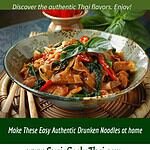
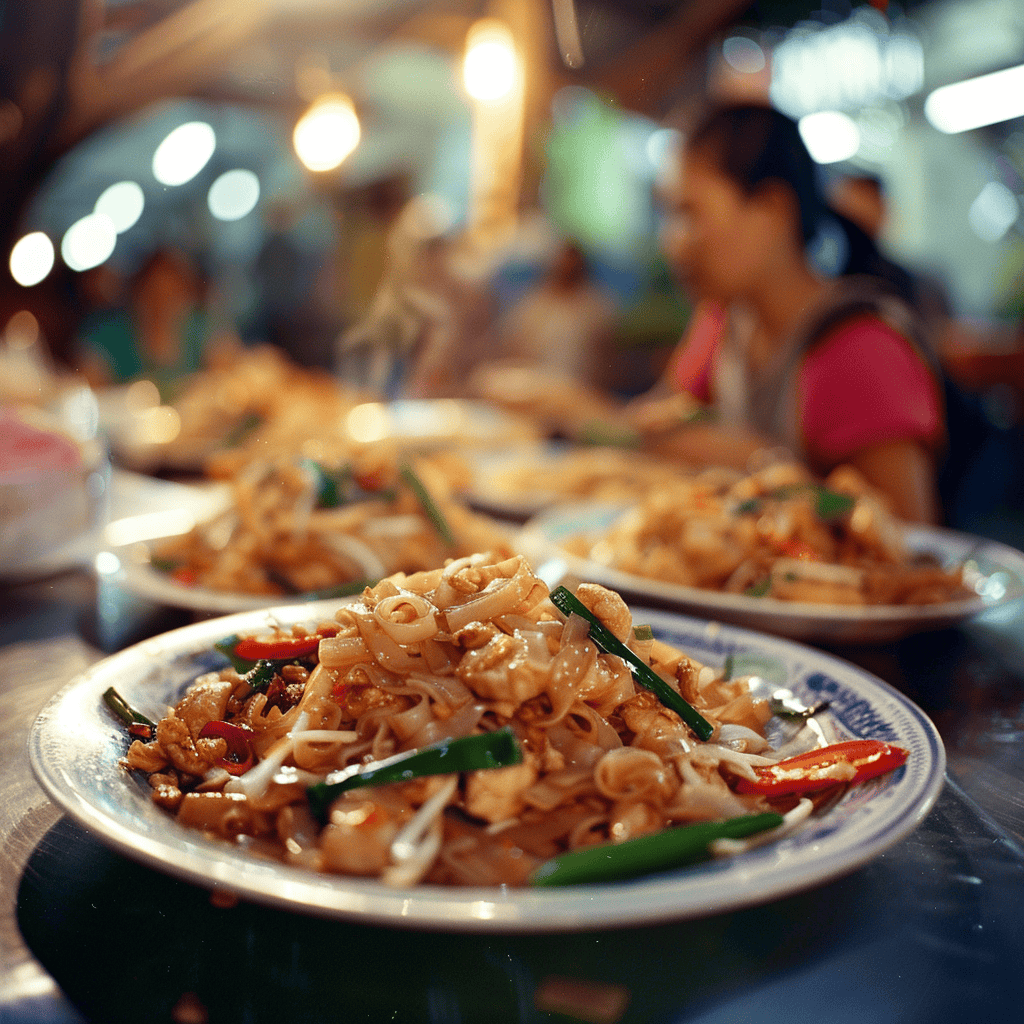
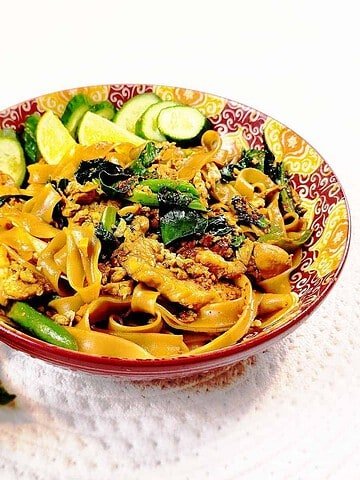
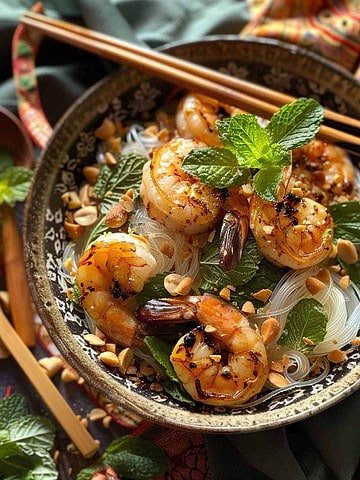
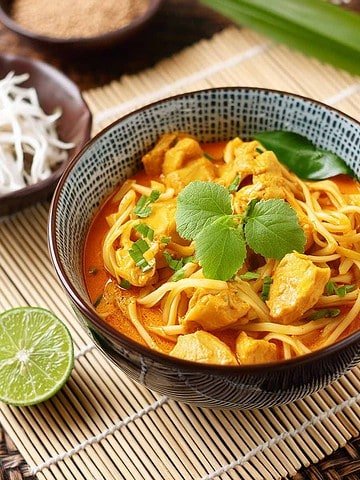
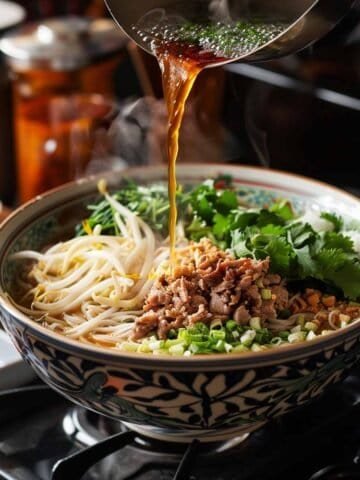
Leave a Reply